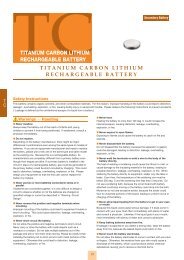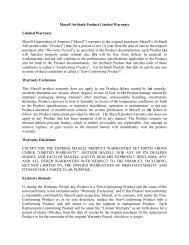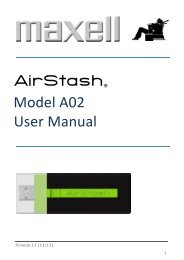Cylindrical CR catalog [PDF 1.61MB] - Maxell
Cylindrical CR catalog [PDF 1.61MB] - Maxell
Cylindrical CR catalog [PDF 1.61MB] - Maxell
You also want an ePaper? Increase the reach of your titles
YUMPU automatically turns print PDFs into web optimized ePapers that Google loves.
<strong>CR</strong><br />
Primary<br />
Battery<br />
Warnings — Circuit Design for Back-up Use<br />
This is a primary battery and cannot be charged. If used in memory<br />
or RTC back-up applications, be sure to use diodes to prevent<br />
charging from the main power source or other batteries, and a<br />
protective resistor to regulate the current as shown in the figure<br />
below. Note that the points described below should be taken into<br />
careful consideration when selecting diodes and protective resistors.<br />
+5V<br />
Diode<br />
Diode<br />
Protective<br />
resistor<br />
Battery<br />
Load<br />
+5V<br />
Diode<br />
Diode<br />
Diode<br />
Battery<br />
Load<br />
Warnings — Disposal<br />
The battery may be<br />
regulated by national or<br />
local regulation.<br />
Please follow the<br />
instructions of proper<br />
regulation. As electric<br />
capacity is left in a<br />
discarded battery and<br />
it comes into contact<br />
with other metals, it<br />
could lead to<br />
distortion, leakage,<br />
Do not pile up or mix<br />
batteries.<br />
Enlarged view<br />
Electric current flows.<br />
These batteries generate heat.<br />
Tape<br />
+<br />
Battery<br />
(Example of<br />
battery insulation)<br />
overheating, or explosion, so make sure to cover the (+) and (-)<br />
terminals with friction tape or some other insulator before disposal.<br />
—<br />
Example (A)<br />
Supplied voltage to load<br />
Because a diode and a resistor generate the voltage drop on<br />
operating, please take into consideration these voltage drops for<br />
supplied voltage to load.<br />
Using diodes to prevent charging<br />
Please choose diodes with leak current as small as possible. Please<br />
keep the charged capacity due to leak current to within 1% of<br />
nominal capacity.<br />
Using and setting protective<br />
resistors<br />
A protective resistor is used to<br />
prevent the battery from being<br />
charged by large surges of current<br />
during diode failure. Please set the<br />
resistor so that the maximum<br />
current shown in the right table is<br />
not exceeded. For example, say a<br />
<strong>CR</strong>2032 battery is used in sample<br />
circuit (A) in combination with a<br />
main power source 5 volt. Since the<br />
permitted charge current is 10mA<br />
and this battery’s voltage is 3V, let<br />
the resistor be<br />
R> = (5V-3V)/10mA=0.2k ohm,<br />
meaning that at least 0.2k ohm is<br />
required.<br />
Type<br />
<strong>CR</strong>2450HR<br />
<strong>CR</strong>2450HR-Ex<br />
<strong>CR</strong>2050HR<br />
<strong>CR</strong>2450<br />
<strong>CR</strong>2430<br />
<strong>CR</strong>2032H<br />
<strong>CR</strong>2032<br />
<strong>CR</strong>2025<br />
<strong>CR</strong>2016<br />
<strong>CR</strong>1632<br />
<strong>CR</strong>1620<br />
<strong>CR</strong>1616<br />
<strong>CR</strong>1220<br />
<strong>CR</strong>1216<br />
<strong>CR</strong>1025<br />
<strong>CR</strong>17450<br />
<strong>CR</strong>17335<br />
Example (B)<br />
Maximum Current<br />
15mA<br />
15mA<br />
10mA<br />
15mA<br />
15mA<br />
10mA<br />
10mA<br />
10mA<br />
10mA<br />
4.0mA<br />
4.0mA<br />
2.5mA<br />
3.0mA<br />
2.5mA<br />
2.5mA<br />
20mA<br />
20mA<br />
Caution — Handling/Storage<br />
Never expose the battery to ultrasonic sound.<br />
Exposing the battery to ultrasonic sound may cause short-circuiting<br />
because the inside material is broken into pieces, leading to<br />
distortion, leakage, overheating, explosion, or fire.<br />
Never subject the battery to severe shock.<br />
Dropping, throwing or stomping on the battery may cause distortion,<br />
leakage, overheating, explosion, or fire.<br />
Never short-circuit the battery while installing into equipment.<br />
Please be careful when installing the battery not to short-circuit it with<br />
metal portions of the equipment.<br />
Use the correct battery suitable for the equipment.<br />
The battery may not be suitable for the specific equipment due to the<br />
using conditions or type of equipment. Please select the suitable<br />
battery according to the handling instructions of the equipment.<br />
Never use or leave the battery in a hot place such as under the direct<br />
rays of the sun or in a car in hot weather.<br />
If you do, this may cause distortion, leakage, overheating, explosion,<br />
or fire.<br />
Never allow the battery to come in contact with water.<br />
If it does, this may cause the battery to rust or lead to distortion,<br />
leakage, overheating, explosion, or fire.<br />
Never store the battery in a hot and highly humid environment.<br />
Doing so may cause the performance of the battery to deteriorate. In<br />
certain environments, this may lead to distortion, leakage,<br />
overheating, explosion, or fire.<br />
C<br />
R<br />
23<br />
Note: If the diodes broke down, it is necessary for safety to replace<br />
them as soon as possible even though using a protective resistor.<br />
Considering the trouble of diodes and resistors, other safety<br />
measures should be incorporated in the circuit design.<br />
Keep contact pressure more than 2N.<br />
The battery voltage may be lower than intended value because of<br />
poor contact condition, please keep contact pressure more than 2N<br />
for suitable contact resistance.


![Cylindrical CR catalog [PDF 1.61MB] - Maxell](https://img.yumpu.com/32837016/2/500x640/cylindrical-cr-catalog-pdf-161mb-maxell.jpg)

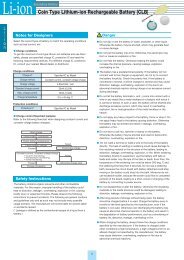


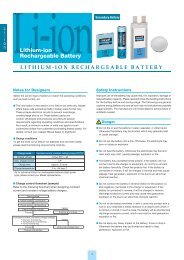
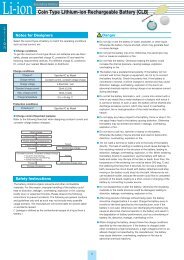
![CLB 电池å•元目录[PDF 1.07MB] - Maxell](https://img.yumpu.com/33415090/1/190x257/clb-aaauaaa-aaaoaaaaaaraa-1-2-aopdf-107mb-maxell.jpg?quality=85)
